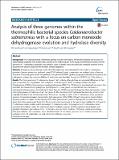Por favor, use este identificador para citar o enlazar a este item:
http://hdl.handle.net/10261/123621COMPARTIR / EXPORTAR:
 SHARE SHARE
 CORE
BASE CORE
BASE
|
|
| Visualizar otros formatos: MARC | Dublin Core | RDF | ORE | MODS | METS | DIDL | DATACITE | |

| Título: | Analysis of three genomes within the thermophilic bacterial species Caldanaerobacter subterraneus with a focus on carbon monoxide dehydrogenase evolution and hydrolase diversity |
Autor: | Sant'Anna, F. H.; Lebedinsky, A. V.; Sokolova, T.; Robb, F. T.; González Grau, Juan Miguel CSIC ORCID | Palabras clave: | Caldanaerobacter subterraneus Carbon monoxide dehydrogenase Esterase Genome Glycosidase Horizontal gene transfer Hydrogenase Phylogeny Protease Thermophile |
Fecha de publicación: | 7-oct-2015 | Editor: | Elsevier | Citación: | BMC Genomics 16: 757 (2015) | Resumen: | [Background] The Caldanaerobacter subterraneus species includes thermophilic fermentative bacteria able to grow on carbohydrates substrates with acetate and L-alanine as the main products. In this study, comprehensive analysis of three genomes of C. subterraneus subspecies was carried in order to identify genes encoding key metabolic enzymes and to document the genomic basis for the evolution of these organisms. [Methods] Average nucleotide identity and in silico DNA relatedness were estimated for the studied C. subterraneus genomes. Genome synteny was evaluated using R2CAT software. Protein conservation was analyzed using mGenome Subtractor. Horizontal gene transfer was predicted through the GOHTAM pipeline (using tetranucleotide composition) and phylogenetic analyses (by maximum likelihood). Hydrolases were identified through the MEROPS and CAZy platforms. [Results] The three genomes of C. subterraneus showed high similarity, although there are substantial differences in their gene composition and organization. Each subspecies possesses a gene cluster encoding a carbon monoxide dehydrogenase (CODH) and an energy converting hydrogenase (ECH). The CODH gene is associated with an operon that resembles the Escherichia coli hydrogenase hyc/hyf operons, a novel genetic context distinct from that found in archetypical hydrogenogenic carboxydotrophs. Apart from the CODH-associated hydrogenase, these bacteria also contain other hydrogenases, encoded by ech and hyd genes. An Mbx ferredoxin:NADP oxidoreductase homolog similar to that originally described in the archaeon Pyrococcus furiosus was uniquely encoded in the C. subterraneus subsp. yonseiensis genome. Compositional analysis demonstrated that some genes of the CODH-ECH and mbx operons present distinct sequence patterns in relation to the majority of the other genes of each genome. Phylogenetic reconstructions of the genes from these operons and those from the ech operon are incongruent to the species tree. Notably, the cooS gene of C. subterraneus subsp. pacificus and its homologs in C. subterraneus subsp. tengcongensis and C. subterraneus subsp. yonseiensis form distinct clades. The strains have diverse hydrolytic enzymes and they appear to be proteolytic and glycolytic. Divergent glycosidases from 14 families, among them amylases, chitinases, alpha-glucosidases, beta-glucosidases, and cellulases, were identified. Each of the three genomes also contains around 100 proteases from 50 subfamilies, as well about ten different esterases. Conclusions: Genomic information suggests that multiple horizontal gene transfers conferred the adaptation of C. subterraneus subspecies to extreme niches throughout the carbon monoxide utilization and hydrogen production. The variety of hydrolases found in their genomes indicate the versatility of the species in obtaining energy and carbon from diverse substrates, therefore these organisms constitute a remarkable resource of enzymes with biotechnological potential. © 2015 Sant'Anna et al. |
Descripción: | 14 páginas.-- 5 figuras.-- 1 tabla.-- 80 referencias.-- Supporting data are included as Additional files. Phylogenetic data have been deposited at Tree BASE under the accession URL http://purl.org/phylo/treebase/phylows/study/TB2:S18113.-- The electronic version of this article is the complete one and can be found online at: http://www.biomedcentral.com/1471-2164/16/757 | Versión del editor: | http://dx.doi.org/10.1186/s12864-015-1955-9 | URI: | http://hdl.handle.net/10261/123621 | DOI: | 10.1186/s12864-015-1955-9 | ISSN: | 1471-2164 |
| Aparece en las colecciones: | (IRNAS) Artículos |
Ficheros en este ítem:
| Fichero | Descripción | Tamaño | Formato | |
|---|---|---|---|---|
| Analysis_three_genomes_within2015JMGG.pdf | 893,24 kB | Adobe PDF |  Visualizar/Abrir |
CORE Recommender
PubMed Central
Citations
15
checked on 28-mar-2024
SCOPUSTM
Citations
26
checked on 15-abr-2024
WEB OF SCIENCETM
Citations
22
checked on 26-feb-2024
Page view(s)
663
checked on 21-abr-2024
Download(s)
343
checked on 21-abr-2024

